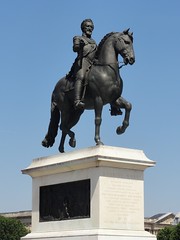
PREV ARTICLE
NEXT ARTICLE
FULL ISSUE
PREV FULL ISSUE
MORE ON THE 1604 HENRY IIII MEDAL
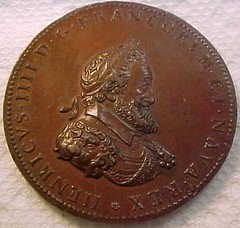
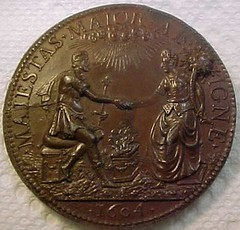
Regarding Michael Sanders' 1604 Henry IIII medal, Rick Stroman writes: I found out a similar medal was auctioned at Baldwin's auction of the Michael Hall Collection in Miami, FL on May 4/5, 2010 as Lot 279 for a realized price of 220 pounds($351.00 USD). A copy of the catalog page with price realized written is attached.

Tony Lopez writes: This 1604 medal is generally described in recent auctions as a generic medal of Henri IV and his wife Marie De’Medici, done by Phillipe Danfrie the younger. The medal is seen with two obverses both featuring a laureated and cuirrased bust of Henri IV in profile facing right, with the surrounding legend HENRICVS IIII DG FRANCORVM ET NAVA REX as seen in this undated obverse medal owned by Michael Sanders. The differences in the other obverse are that it has a 1604 date below the bust, drapery, and larger lettering using NAVAR vs. NAVA. From what I can tell, the 1604 dated obverse is the original obverse, and the undated obverse is a later copy restrike die from the late 18th/early 19th century. In fact, late 20th century restrikes of this design continued to be struck using the undated obverse design; I have seen silver and bronze copies of these sell for about 100€ and 20€ respectively. The reverse of the medal has the legend MAIESTAS MAIOR AB IGNE (Majesty greater than the fire) surrounding above an allegorical design of King Henri IV holding a scepter, sitting across from his second wife Queen Marie De’ Medici holding a cornucopia, face to face and holding hands over a flaming votive alter below the clouds and heaven above, and date 1604 in exergue below.
Pont Neuf is now the oldest bridge crossing the Seine in Paris. The statue, completed in 1618 (after Henri IV's death in 1610) was destroyed during the French Revolution, but was replaced in 1818 and still stands today. The most significant historic event which occurred in 1604 for Henry IV was the Peace Treaty made with Sultan Ahmet I and the Ottoman Empire, so this could explain the reverse legend as well - but I could not locate any contemporaneous references supporting this. Another possibility, given the Votive Altar, was that the medal was referring to the religious strength of the Monarchy or its connection to Catholicism, the Vatican and God. Henry IV, originally a Calvinist, twice converted to Catholicism, and Marie came from The House of Medici which was a great benefactor to the Vatican. Four members of the Medici family rose to the Papacy, including Leo XI who became pope the following year on April 1, 1605; though he died only 26 days later. Between the three possibilities, perhaps a combination of the queen's generosity, and the Monarchy's Catholicism and connection to God is being celebrated by this medal. Michael Sanders' example of the medal does not ring, so I would venture a guess that it is a copper lead filled electrotype, explaining the pristine copper finish; but could not be certain without it in hand. As far as value for struck examples, the Baldwin’s May 10, 2010 Michael Hall collection had three examples of this medal, lots 278-280, all listed as later 18th-19th century restrikes. Lot 278 in silver (1604 dated) realized £540, Lot 279 in bronze (dated) realized £220, and lot 280 (undated) realized £90. A Stacks - Coin Galleries October 2010 lot 2839 example in silver which was likely a later restrike realized $402.50. It is noteworthy that that same silver Lot 278 medal that sold at Baldwins in the Michael Hall collection for £540 was subsequently sold later that same year in the December 11, 2010 Jean Elsen Auction 107 as Lot 1319 (listed as 58 mm diameter by Baldwin’s and 56 mm by Elsen but easily identified as the same piece by the number “XVI” marked on the edge), and realized 2200€. (In dollars, that is $872 vs. $3010, a nearly 350% increase in auction price in seven months!) With this startling jump in result, it could be that bidders determined that this silver example was a more valuable original early 17th century strike, though I don't know myself. I have attached 3 images of medals I found, the silver Michael Hall medal dated 1604 on the obverse (from Elsen), a copper holed 1604 dated piece (from MA Shops but I don't remember where), and a 20th century Paris restrike with a 1970 edge mark from an old eBay listing. The 4th pic is of the Henry IV equestrian statue at Pont Neuf.
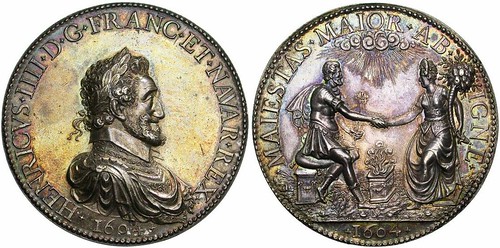
Elsen-Baldwin's silver Henry IV
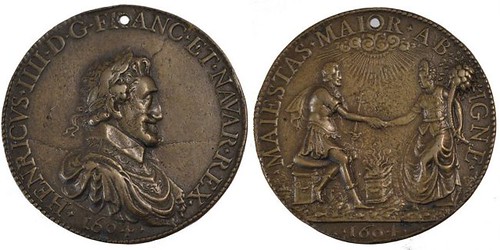
1604 dated copper
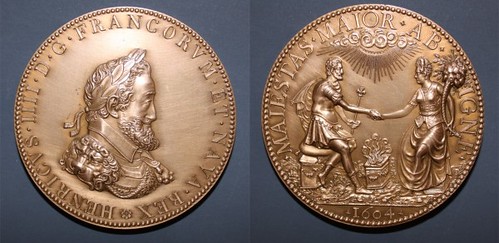
circa 1970 restrike
Thanks, folks!
-Editor
To read the earlier E-Sylum article, see: 1604 HENRY IIII MEDAL INFORMATION SOUGHT (www.coinbooks.org/esylum_v16n42a18.html)
THE BOOK BAZARREWayne Homren, Editor The Numismatic Bibliomania Society is a non-profit organization promoting numismatic literature. See our web site at coinbooks.org. To submit items for publication in The E-Sylum, write to the Editor at this address: whomren@gmail.com To subscribe go to: https://my.binhost.com/lists/listinfo/esylum All Rights Reserved. NBS Home Page Contact the NBS webmaster 
|
